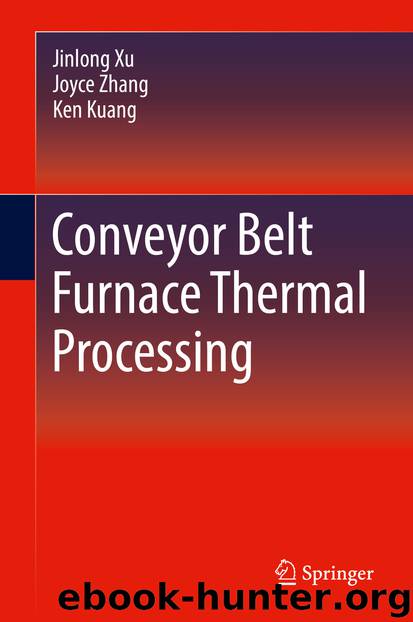Conveyor Belt Furnace Thermal Processing by Jinlong Xu Joyce Zhang & Ken Kuang

Author:Jinlong Xu, Joyce Zhang & Ken Kuang
Language: eng
Format: epub
Publisher: Springer International Publishing, Cham
The open and close of valves are decided by the cylinder piston positions. A detailed explanation by Marshall Brain on how engine works can be found at http://auto.howstuffworks.com/engine4.htm.
Engine Valve Heat Treatment Description
The working conditions of engine valves are severe. Doug Kaufman states that intake valves typically run at the range of 800–1000 °F(427–538 °C), while exhaust valves typically run at 1200–1450 °F(649–788 °C), due to the temperature difference of intake gas and exhaust. Besides high temperature, valve also experiences cyclic loading. A valve can open and close dozens of times per second.
Because of the high working temperature and strength required in such conditions, heat-resistant steels are often used. Besides proper material selection, proper heat treatment is essential in manufacturing high performance engine valves. It is vital to create the desired properties like strength, wear resistance, toughness, fatigue strength, hardness, and microstructure.
Normal heat treating methods include annealing, normalizing, tempering, and hardening. To decide a specific heat treatment process, alloy phase diagram (Fig. 2) is the fundamental tool.
Fig. 2.Fe-C phase diagram (Courtesy of online source http://www.calphad.com/iron-carbon.html)
Download
This site does not store any files on its server. We only index and link to content provided by other sites. Please contact the content providers to delete copyright contents if any and email us, we'll remove relevant links or contents immediately.
| Automotive | Engineering |
| Transportation |
Whiskies Galore by Ian Buxton(41524)
Introduction to Aircraft Design (Cambridge Aerospace Series) by John P. Fielding(32883)
Small Unmanned Fixed-wing Aircraft Design by Andrew J. Keane Andras Sobester James P. Scanlan & András Sóbester & James P. Scanlan(32569)
Craft Beer for the Homebrewer by Michael Agnew(17927)
Turbulence by E. J. Noyes(7690)
The Complete Stick Figure Physics Tutorials by Allen Sarah(7135)
Kaplan MCAT General Chemistry Review by Kaplan(6589)
The Thirst by Nesbo Jo(6432)
Bad Blood by John Carreyrou(6271)
Modelling of Convective Heat and Mass Transfer in Rotating Flows by Igor V. Shevchuk(6219)
Learning SQL by Alan Beaulieu(6029)
Weapons of Math Destruction by Cathy O'Neil(5822)
Man-made Catastrophes and Risk Information Concealment by Dmitry Chernov & Didier Sornette(5641)
Digital Minimalism by Cal Newport;(5388)
Life 3.0: Being Human in the Age of Artificial Intelligence by Tegmark Max(5182)
iGen by Jean M. Twenge(5155)
Secrets of Antigravity Propulsion: Tesla, UFOs, and Classified Aerospace Technology by Ph.D. Paul A. Laviolette(4974)
Design of Trajectory Optimization Approach for Space Maneuver Vehicle Skip Entry Problems by Runqi Chai & Al Savvaris & Antonios Tsourdos & Senchun Chai(4837)
Electronic Devices & Circuits by Jacob Millman & Christos C. Halkias(4739)
